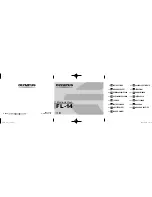
Alarm inputs
The camera has a three-pole terminal block (fig. A-13) for connecting
alarm sensors, such as doorcontacts. For normally open (N.O.) sensors,
connect to contacts N.O.. For normally closed (N.C.) sensors, connect to
contacts N.C..
Position
First you need to determine where the camera is to be installed. The best
results are obtained when the camera looks a little downwards and not
into a bright source of light.
•
Hold the camera in your hand at the spot where you want to install it
and check on the monitor whether the camera does actually cover the
required area from that spot.
•
Fasten the mounting bracket to the ceiling, the wall, or another even and
firm surface by means of the supplied screws and plugs.
•
Tighten the knob (fig. A-3) of the ball-and-socket joint.
•
Fasten the camera to the bracket by screwing the mounting hole in the
back or bottom of the camera (fig. A-1) onto the threaded end (fig. A-2).
•
Loosen the knob of the ball-and-socket joint (fig. A-3) and, if necessary,
the screw (fig. A-4) on the mounting bracket and direct the camera
accurately at the object or area you want to have on screen.
•
The knob and screw can be tightened again when the camera is in the
required position.
Remark:
The camera can also be mounted on any other camera tripod
standardly provided with a 1/4" 20 UNC thread.
•
Check if the cable length compensation (fig. A-15) selector is set to the
correct length. The length set must be the same as the length of the
system cable (0-300m/900ft max.) connecting monitor and camera.
Focus adjustment
Adjust the focus ring (fig. B-1) of the camera lens to obtain an optimal
image sharpness.
g
3
























